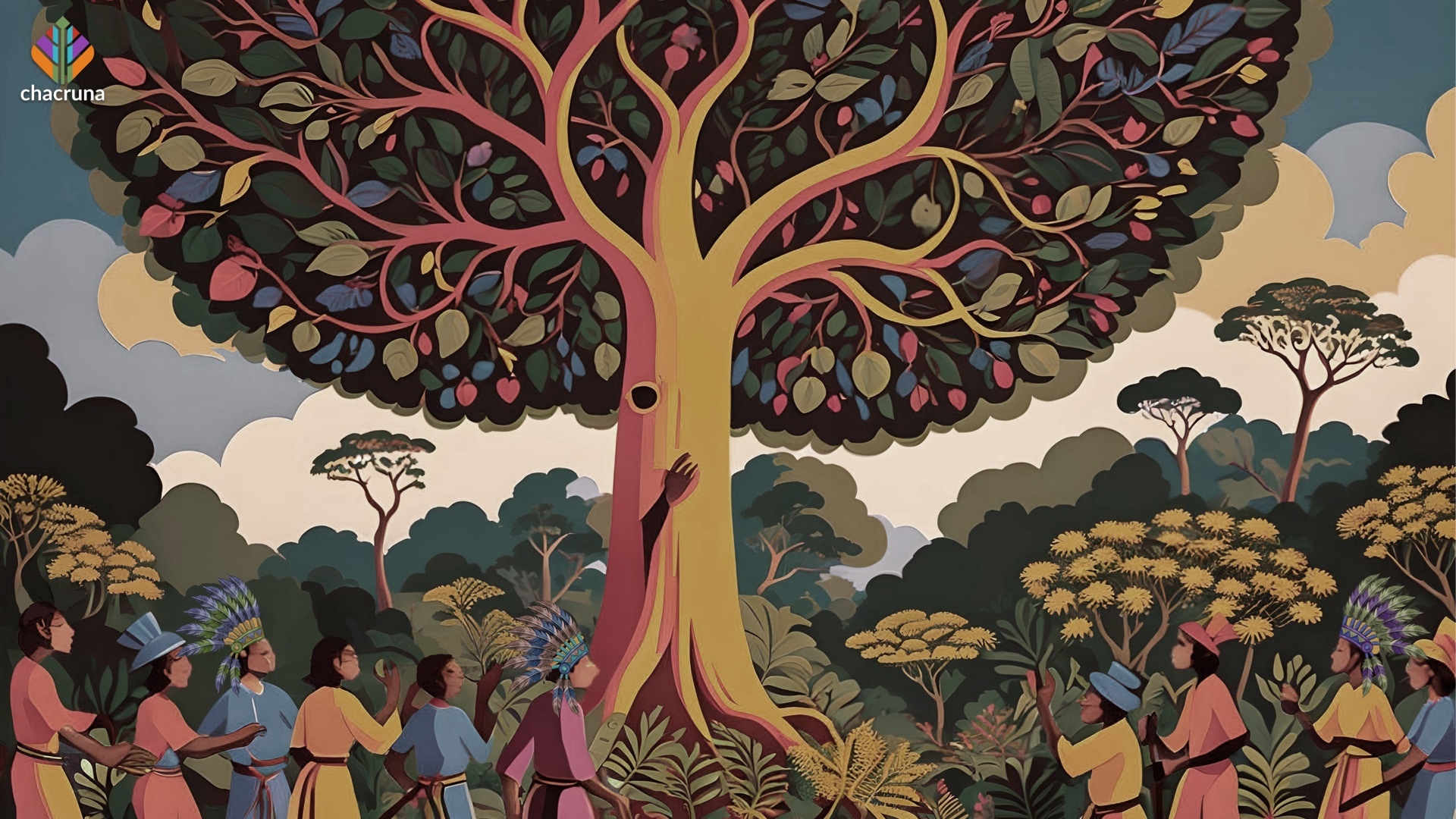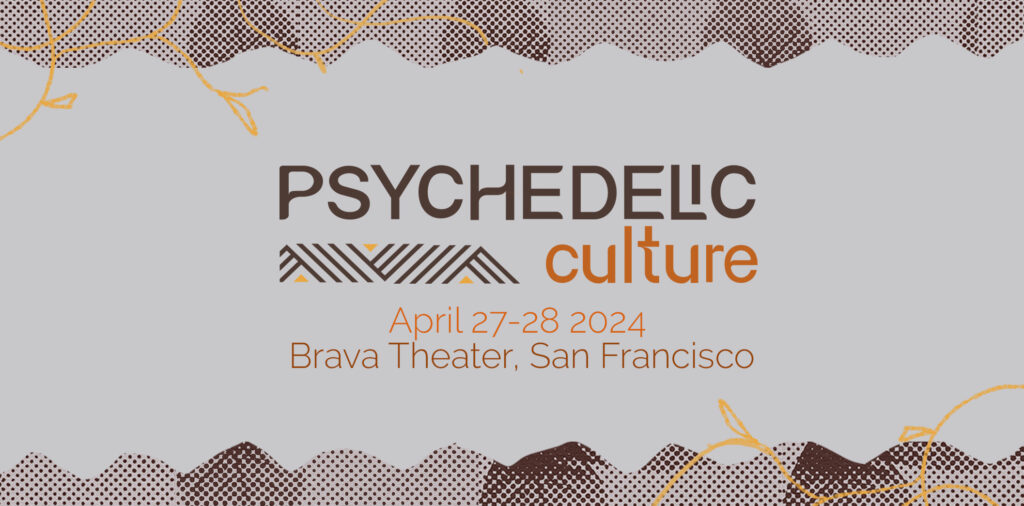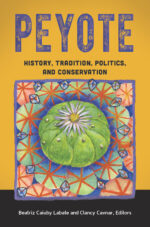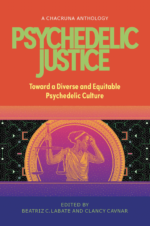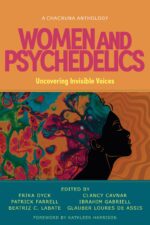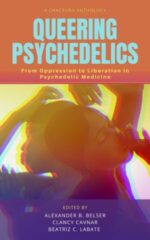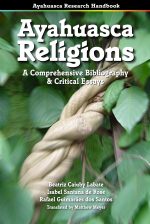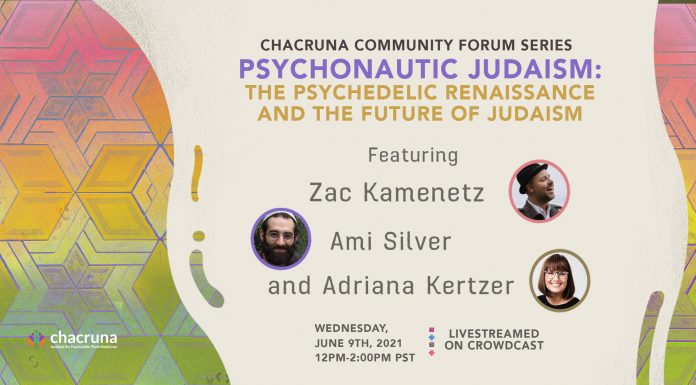- After 2024, the Scenario for Psychedelic Therapies Can Only Improve - January 16, 2025
- Symposium in Brazil Debates Psychedelics at a Political Crossroads - December 13, 2024
- Conference in Rio Defends Psychedelics in Public Health - December 11, 2024
Breakfast in the terreiro‘s collective kitchen had just begun to include fried tripe when hissing sounds sounded. There were whistles announcing the arrival of the delegation from the Brejo do Burgo Indigenous village. Fireworks began to go off, and everyone left the food on the table to head to the portico of the sacred area of the Pankararé.
The Amaro Science Festival (Festa da Ciência do Amaro), open to the general public since 1995, began. Leading the group coming from the village 14 km away was Edézia Maria da Conceição Feitoza, 69 years old, the “Mãe Véia” (Old Mother) of the terreiro, also known as Dona Deza, married to Chief Afonso Enéas, 74.
The woman leader of the ethnic group was received by the members of this Indigenous people in the State of Bahia at the blue gates under a whitewashed masonry arch, with a cross at the top, which read “God bless you all.” Most of them dressed in ceremonial caroá fiber skirts, were organized in two lines starting from the entrance decorated with palm leaves.
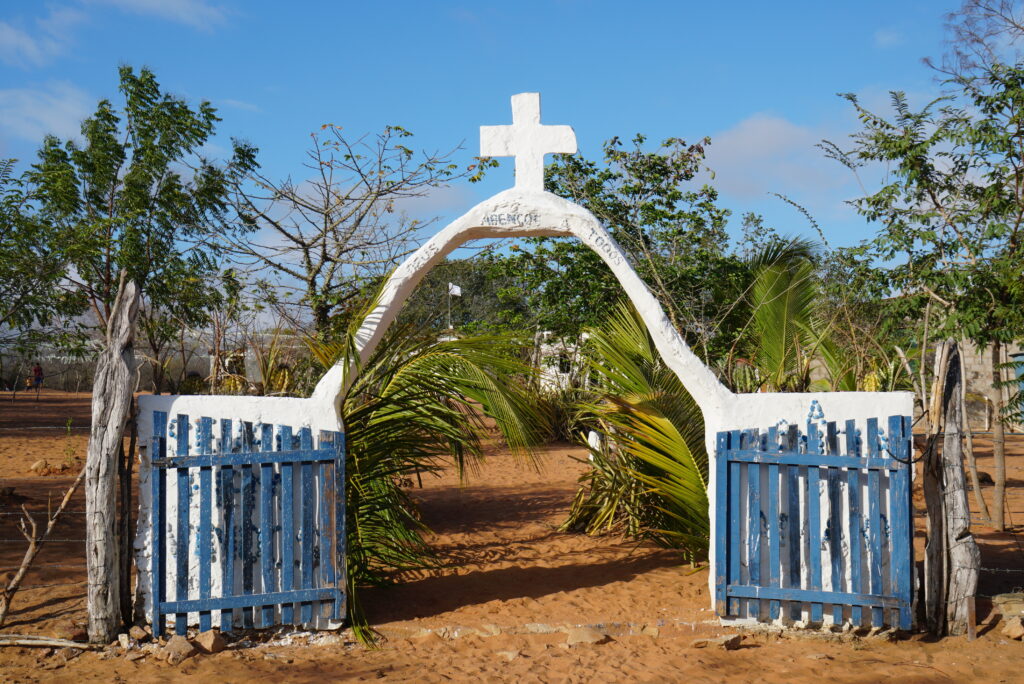
The whistle of the gaitas, instruments halfway between whistles and flutes, gave way to the enveloping hiss of the maracas. These instruments made from gourds always accompany toantes, songs with a few verses called by a leading voice and repeated by everyone else. An example:
In my science there are many enchanted things to play with
In my science there are many enchanted things to play with
With the strength of Jurema and the strength of juremá
With the strength of Jurema and the strength of juremá
In the Amaro terreiro we will celebrate
With the Enchanted ones of the forests and my jatobá tree.
This is not just any jatobá, but the sacred tree that gave rise to the Amaro terreiro and serves as the home of Caboclo Aboiador. This enchanted (entity, spirit) occupies a central place in the Pankararé pantheon.
This is not just any jatobá, but the sacred tree that gave rise to the Amaro terreiro and serves as the home of Caboclo Aboiador. This enchanted (entity, spirit) occupies a central place in the Pankararé pantheon.
Amidst the parched caatinga, the evergreen canopy of the sacred jatobá tree covers the fenced area of around 400 m2. You can only enter it through the circular building called Poró dos Homens (men’s shed) and only people of that gender and over 16 years of age can enter the space.
There gathered the men who would dance at night dressed as praiás, an outfit made with caroá fibers that covers them from head to toe and represents the enchanted forces of the forest. The jurema wine was kept under a small shed, a special place for the sacrament used by the Pankararé to facilitate communication with enchanted beings.
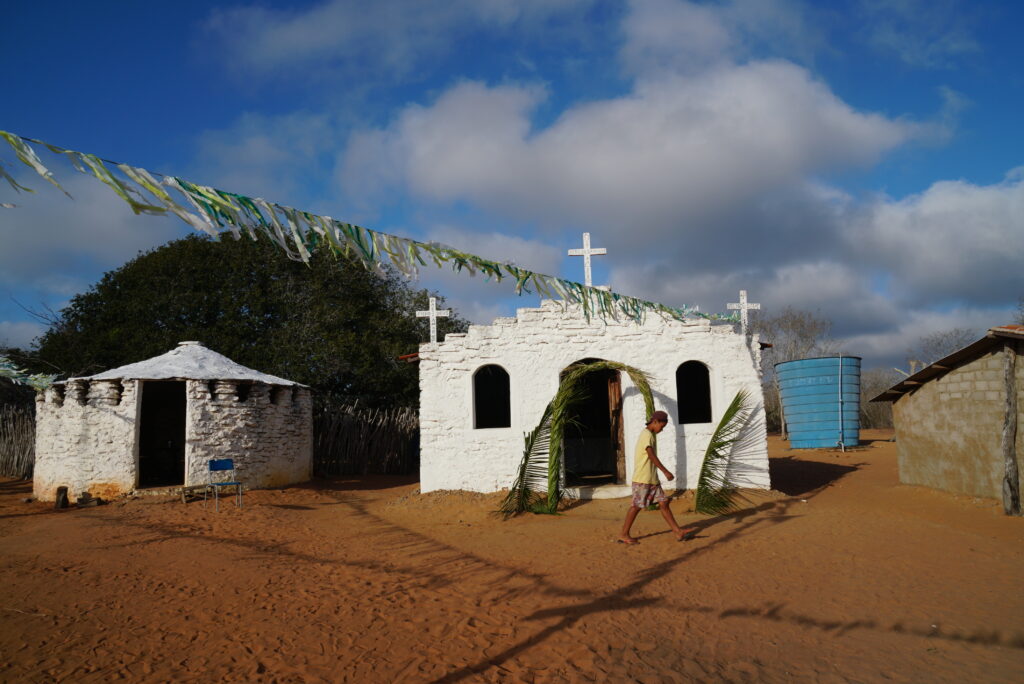
“The jurema is what Our Lord blessed for the population to drink,” chief Enéas answered vaguely, after a few seconds of silence, to the question about the role of the drink in the ritual. He only explained that wine can only be made with jurema-de-caboclo, a thornless variety of jurema-preta (Mimosa tenuiflora), a small tree that also grows in Mexico and is known there as tepezcohuite.
The bark of the Jurema-preta roots contains N,N-dimethyltryptamine (DMT), the same psychedelic substance that causes the mirações (visions) of another sacramental drink, ayahuasca, a tea used by dozens of traditional peoples in the Amazon rainforest. At the beginning of the 20th century, its use gave rise to urban religions in Brazil such as Santo Daime, União do Vegetal (UDV), and Barquinha.
Jurema, a medium-sized pioneer tree common in the caatinga (semi-arid biome in Northeastern Brazil), is a common element among several ethnicities in the dry hinterland.
It is a mixed-race population, whose customs were almost entirely erased during the colonial period, with the forced settlements run by Jesuits and other Catholic orders. Most of the original languages have become extinct, with the exception of the Fulni-ô, who still speak the Yaté language around Águas Belas (State of Pernambuco).
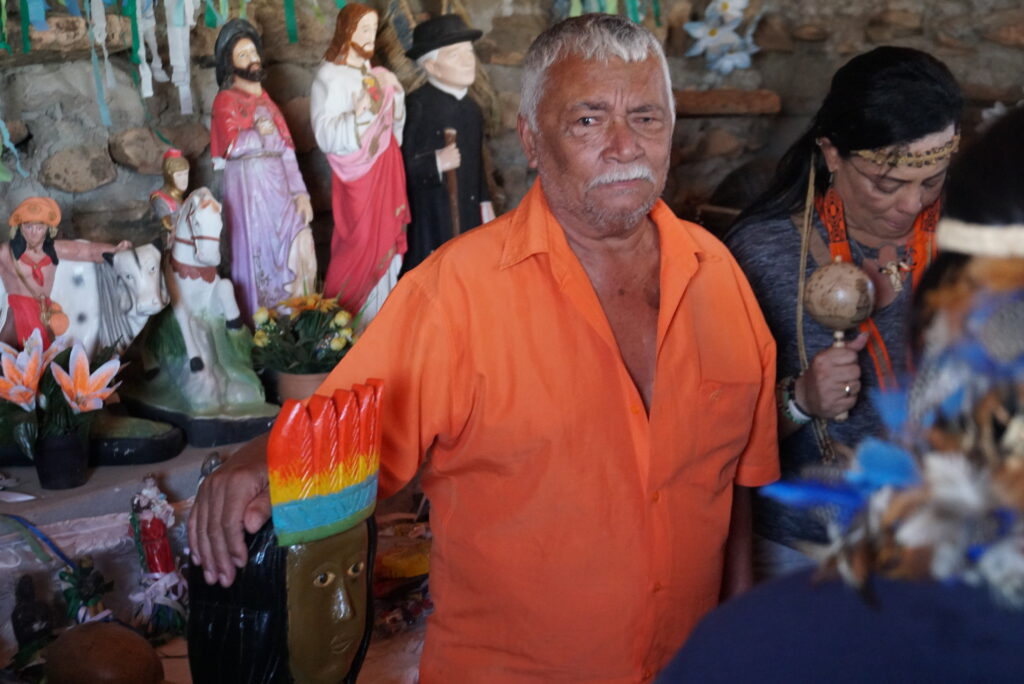
Invisibility was a means of survival, which still manifests itself today in the secrecy surrounding the so-called “science,” the set of cosmology, beliefs, and practices that make up the spirituality of these backland people. Hence Afonso Enéas’s reluctance, for example, to detail the preparation of jurema wine.
“I was attacked a lot,” said the chief. His field of beans and corn was burned, and his fences were torn down. The conflicts involved posseiros (land grabbers), even members of their own people who did not want to be identified as Indigenous, when work began to demarcate the territory in the 1980s by Funai (Brazil’s federal agency for Indigenous peoples).
Today, a total of 47.5 thousand hectares (475 km2) are approved for the 2,400 Pankararé. Another 13 thousand hectares, where the Cerquinha village is located, were demarcated, but the necessary approval by the Ministry of Justice never materialized.
The territory is in the municipality of Glória (Bahia), close to Paulo Afonso, along the right bank of the São Francisco River. With the construction of the Itaparica hydroelectric plant, many people were removed from their lands and relocated, including in the indigenous area.
A similar process accompanied the creation of the Raso da Catarina Ecological Station, a refuge for the Lear’s Macaw, which is threatened with extinction. The region was also famous for the wanderings of Lampião’s band, who made camps there.
Find more information on the upcoming Psychedelic Culture Conference.
In 1979, during the fight for land demarcation, the then chief Ângelo Pereira Xavier was murdered in an ambush, says Elaine Patrícia de Sousa Oliveira, Dona Deza’s daughter-in-law, in her master’s thesis “A Mulher na Ciência do Amaro” (women in the Amaro science), argued on August 31, 2023, at the State University of Bahia.
Years later, Afonso would assume leadership and complete the process of recognizing the Pankararé territory. The conflicts continued, making it difficult to carry out rituals that survived only in oral form, such as the songs that Dona Deza sang since she was a girl.
Walking through the caatinga with cattle raised extensively in the commons system known as fundo de pasto, Afonso one day found himself overcome by the scorching sun when the herd burst. He then found shade under a jatobá tree—the only vegetation with leaves in the parched field—and stopped to rest with his head resting on the trunk.
“All the strength we had [in the fight for demarcation] came from here, from Amaro.”
Chief Enéas Afonso
The cattle returned alone and began licking his feet. There the chief experienced the first appearance of Caboclo Aboiador, the center of the Amaro Festival that his people started to organize, in that same place, annually on the last Saturday of October. “All the strength we had [in the fight for demarcation] came from here, from Amaro,” says the chief.
Several residents of Brejo do Burgo frequent the place, not only for the festivities, but to take care of the trees and facilities such as the kitchen and bathrooms, to erect new buildings, such as the church and the Casa das Mulheres (women’s house) and Poró das Crianças (children’s shed), and hold closed ceremonies, such as the Mesa de Ciência (science table).
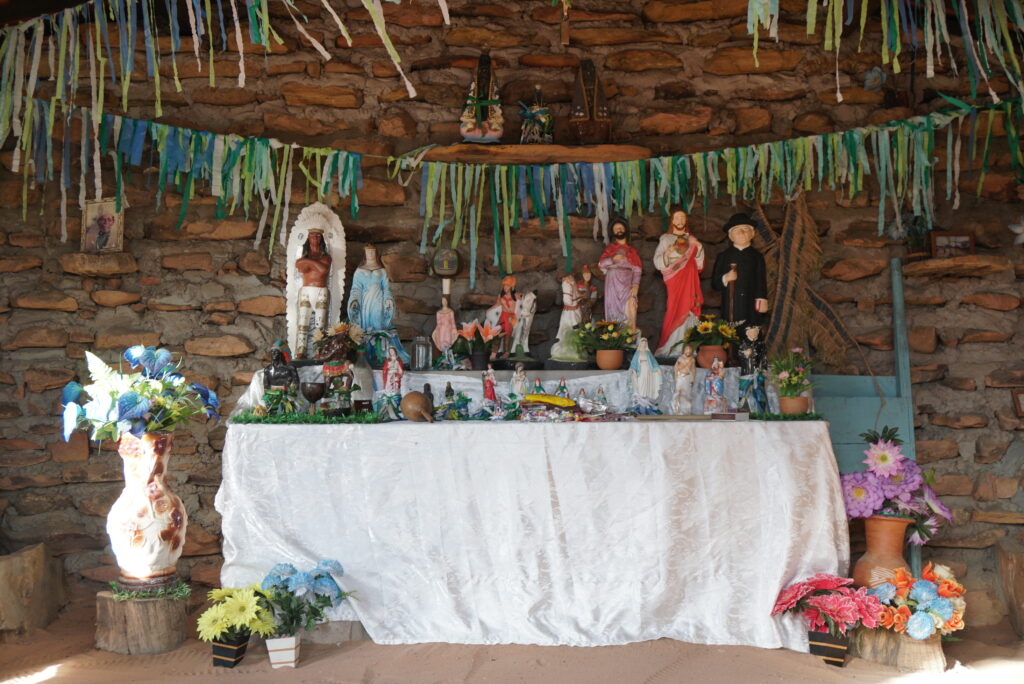
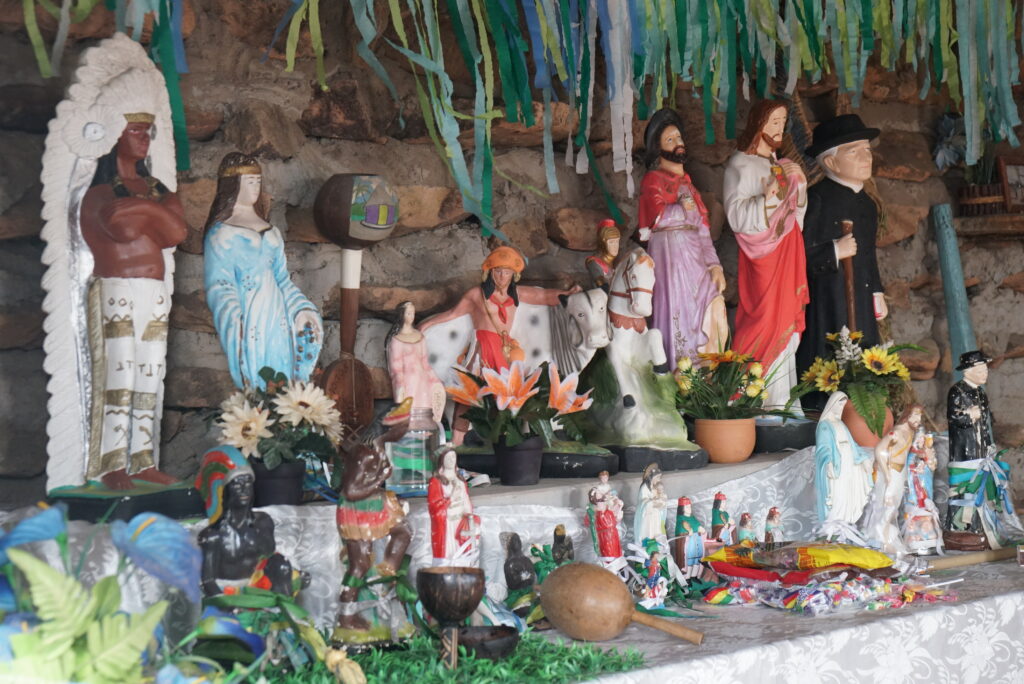
The entire syncretic range of the hinterland religiosity is revealed at the church’s altar with Amerindian, African, and popular Catholicism roots.
There are many images: in addition to Caboclo Aboiador, an Indigenous person with a naked torso and leather cowboy hat, there are statuettes of Father Cícero (a Catholic priest revered in the Northeast), Jesus Christ, Saint George, Iemanjá, Caboclo Pena Branca, Our Lady of Aparecida, Cosme, and Damião…
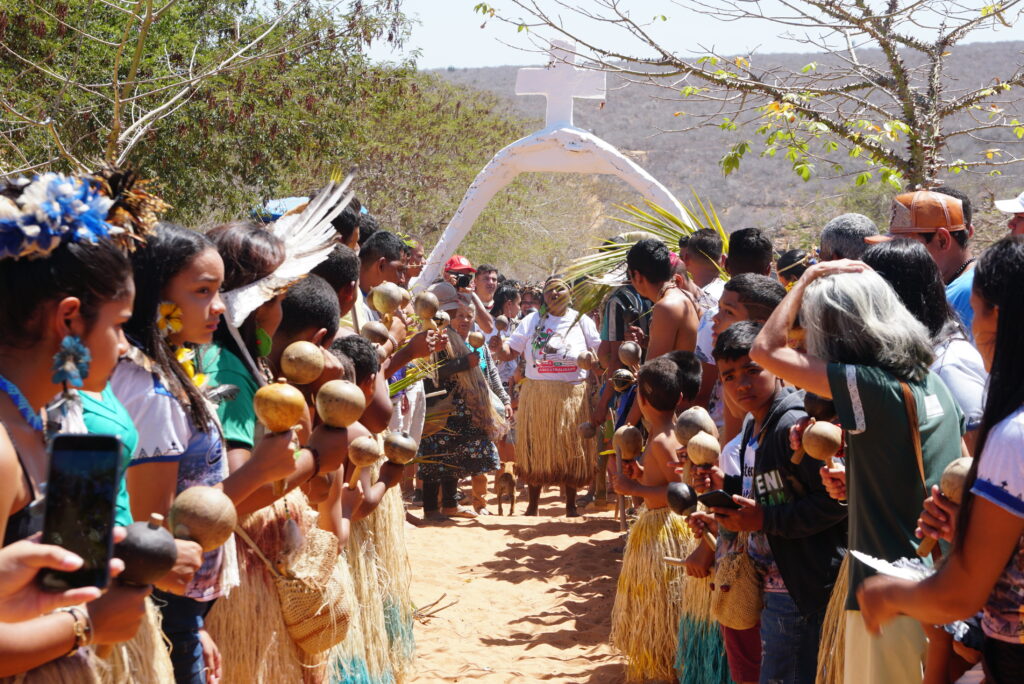
After the arrival of the delegation led by Dona Deza and the toré (circular dance) that follows, the next ritual of the Festa do Amaro are the blessings of the chief in the chapel. He pulls off a tune with stanzas like this:
I am with God
With God I am
I am Caboclo Aboiador
Protect this home we are in
Protect those who arrived and here are
Then the midday prayer would take place in the little church. In the crowded room, chants and prayers take place, such as Hail Marys and Our Fathers sung under the command of three male elders.
There are incorporations of enchanted people, such as the Capitão das Matas (woods’s captain) received by Dona Deza, an entity whose proper name cannot be revealed by the Pankararé. When everyone had left the little church, I went to Old Mother to thank her.
The lady hugged me with firm arms and began to say blessings, asking that Our Lady’s mantle would cover me with love. I burst into tears on that woman’s shoulders, without understanding why. It was disturbing and, at the same time, overwhelming, an emotion that returns every time I revisit the moment.
It takes a lot of faith to remain an atheist, says a friend jokingly. Patrícia, Dona Deza’s daughter-in-law, explains that I was actually hugged by the entity, not by the Amaro matriarch.
Just before the midday prayer, inside the Casa dos Homens under the jatobá tree, an old man was serving the jurema wine. I got in line, knelt, and poured a gourd of the cold-prepared liquid, just with water and macerated jurema root fibers, as Chief Afonso had explained (other recipes may include honey, spices, fruits, and cachaça).
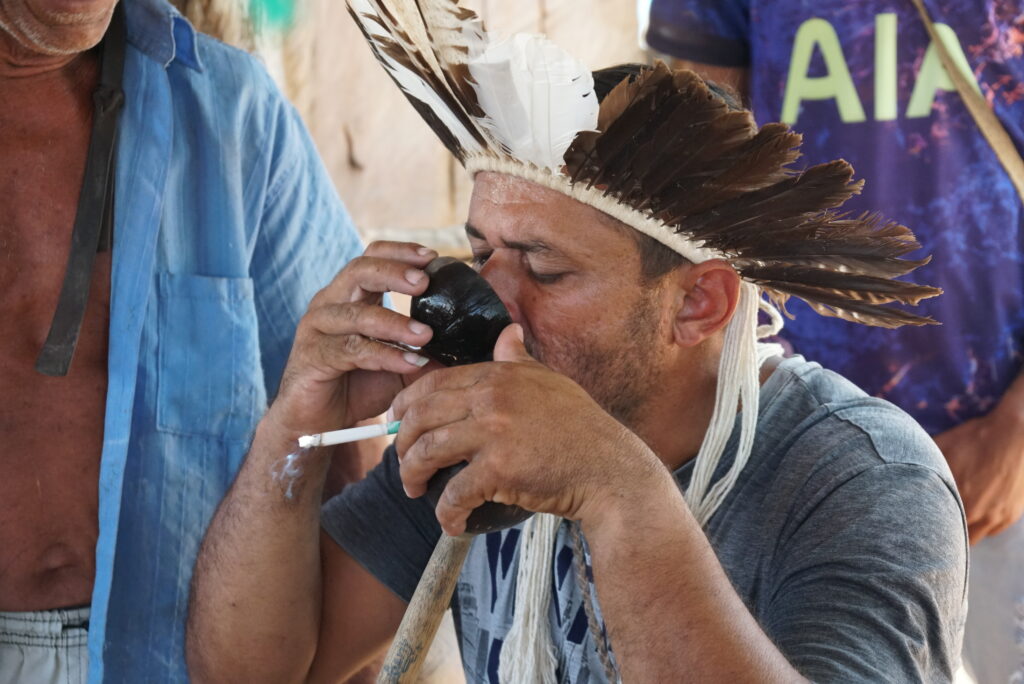
There was no noticeable psychedelic effect. In principle, the drink thus produced does not contain a crucial component: it lacks an inhibitor of the enzyme monoamine oxidase (MAO) that degrades DMT in the digestive tract. (The question remained, however, about how much the drink may have contributed to the crying on Dona Deza’s shoulder.)
In ayahuasca, the inhibitor comes from the jagube vine, or mariri (Banisteriopsis caapi), boiled together with the leaves of the chacruna bush (Psychotria viridis), the source of DMT. Thanks to it, the consciousness-altering compound can reach the bloodstream and, through this route, the brain.
For the Indigenous peoples of Brazil’s Northeast, experiencing contact with the enchanted does not depend on a psychedelic effect. Since the 18th century, however, the chronicle has recorded jurema as producing hallucinations. It cannot be ruled out that some recipes include other sources of inhibitors, such as wild variety of passion fruit.
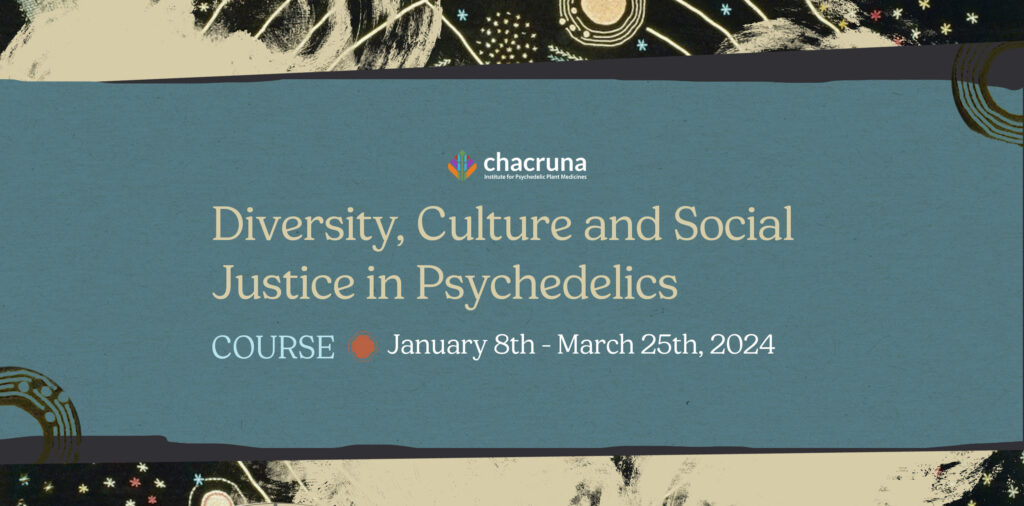
Register for our Diversity, Culture and Social Justice in Psychedelics course HERE.
Communion with the spirits of nature arises from the ritual as a whole: torés, maracas, toantes, smoke from campiôs (conical pipes), caroá costumes, prayers, penances, the portent of the jatobá tree, the celebration of cultural roots and the sharing of meals offered for free by the party organizers, with lots of beef, couscous, rice, and beans.
The delight was evident on everyone’s faces, with no shortage of smiles. The children, in particular, seemed filled with a proud enthusiasm for wearing their caroá kilts and maracas stuffed into their aiós (fiber bags).
At the end of the afternoon, a long procession took place through the caatinga. Leading the procession was a platform with the image of Caboclo Aboiador and other figures, supported by pairs who took turns, including women like Patrícia.
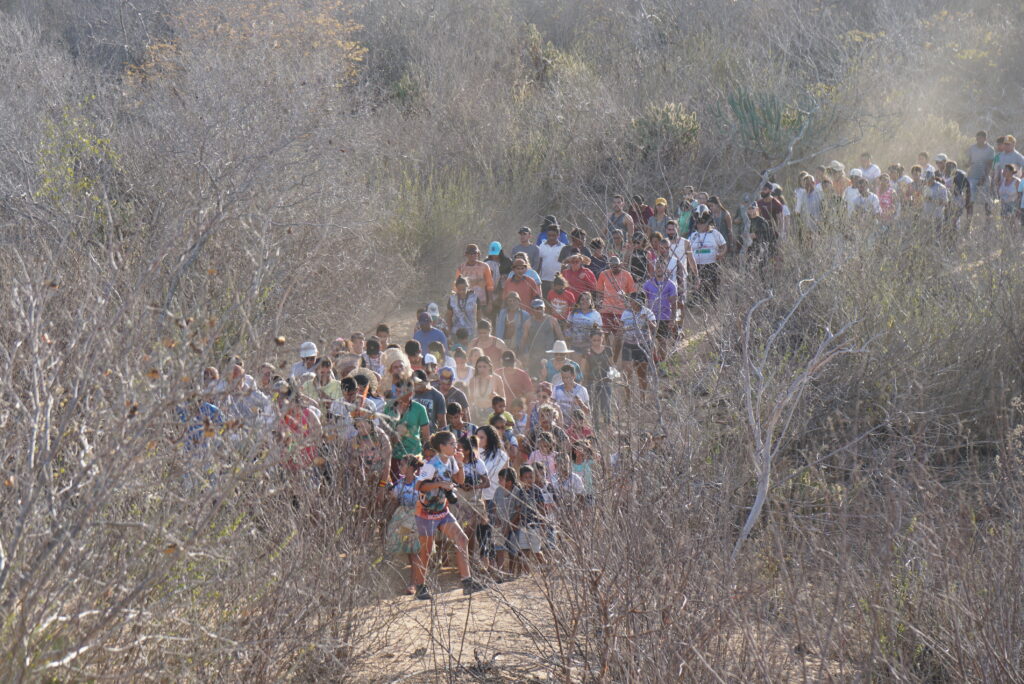
The destination of the procession was the cross on the hill in front, dedicated to Maria Mulambeira, another notable entity in the Pankararé pantheon. The walk on loose, peeling sand only involved stopping at some trees, such as umbuzeiros, revered by the Indigenous people who tied colorful ribbons to them.
Under the whitewashed cross, where the words “Jesus, Mary” were read in blue, Chief Afonso sat next to it. Standing beside him, Patrícia raised the maraca to accompany the chants and prayers, in evident ecstasy. Several people were looking for niches among the rocks to light candles and shelter them from the wind that swept the caatinga.
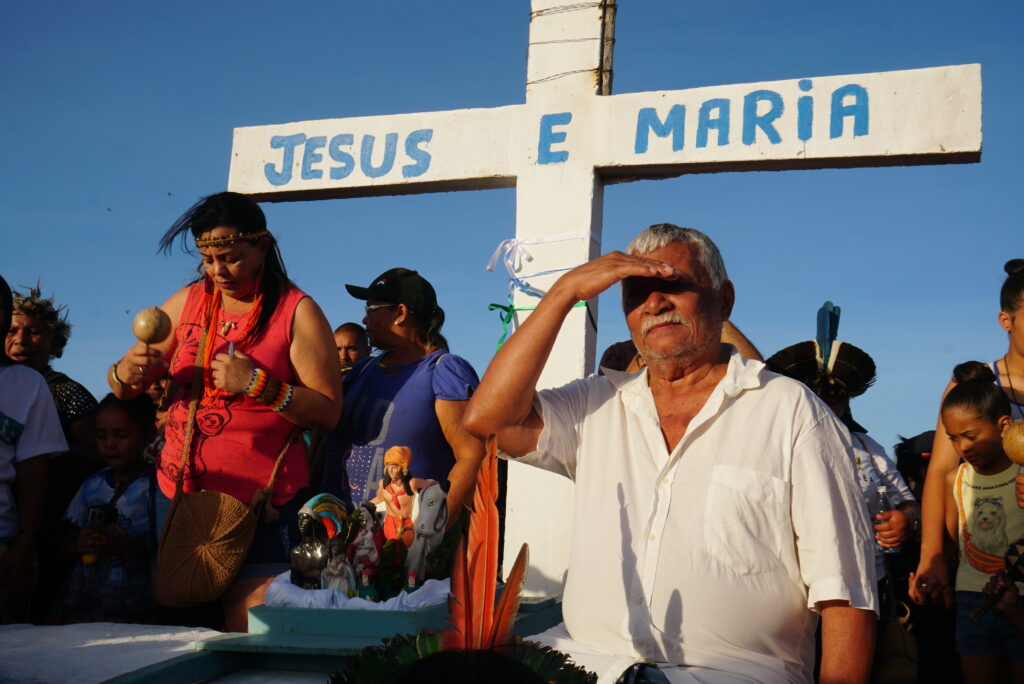
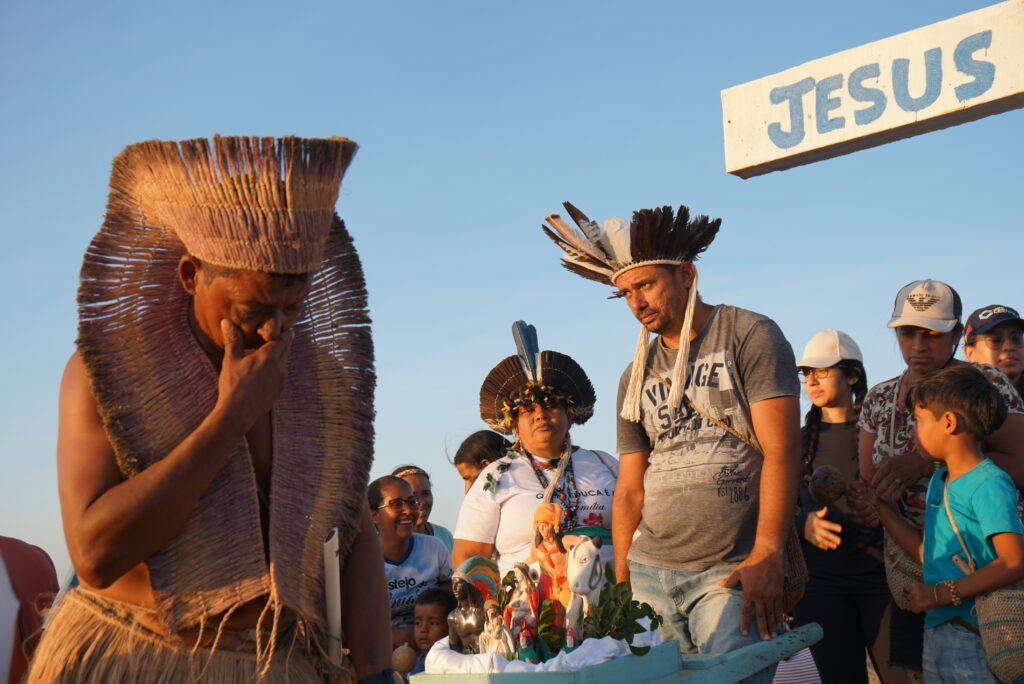
The descent back to the Amaro terreiro took another route, shorter and steeper. The entire route, in the perception of the Indigenous people, resembles the traditional oval representation of the Catholic rosary.
The sun set during the walk back, staining the white forest, a tangle of leafless trunks and branches, with reddish tones. On the opposite side a full moon rose, but with a portion missing on the right flank — a partial lunar eclipse, to boot.
Upon arrival at the party headquarters, a group of young praiá apprentices left the Poró das Crianças for their presentation. They danced and sang in the twilight, much applauded in their effort to continue the tradition.
The real praiás would only appear after dinner. The whistles of gaitas were heard again, coming from the forest to the left of jatobá and Poró dos Homens. Perhaps two dozen ghostly figures descended, filling the yard, illuminated only by the light of the moon and bonfires.

Discover the Indigenous Reciprocity Initiative of the Americas
With the folguedo (fiber outfit) hiding the feet, their quick steps seemed to make them slide fluctuating over the sand. The mask with two small holes for the eyes is topped by a circular feather adornment, making the figures even more imposing. Colorful capes on their backs bore white crosses, reminiscent of medieval crusaders.
A line of women, Dona Deza in the center, pulled the toantes for the praiás to dance. After a few evolutions in line, some accompanied by women, they gathered in circles and emitted half-grunt screams, producing a visceral unison noise —huh! huh!— which resonated in each one’s chest.
It was the highlight of the party. Dozens, perhaps hundreds of firecrackers were fired throughout the celebration and went into the night. A toré followed, with everyone’s participation.
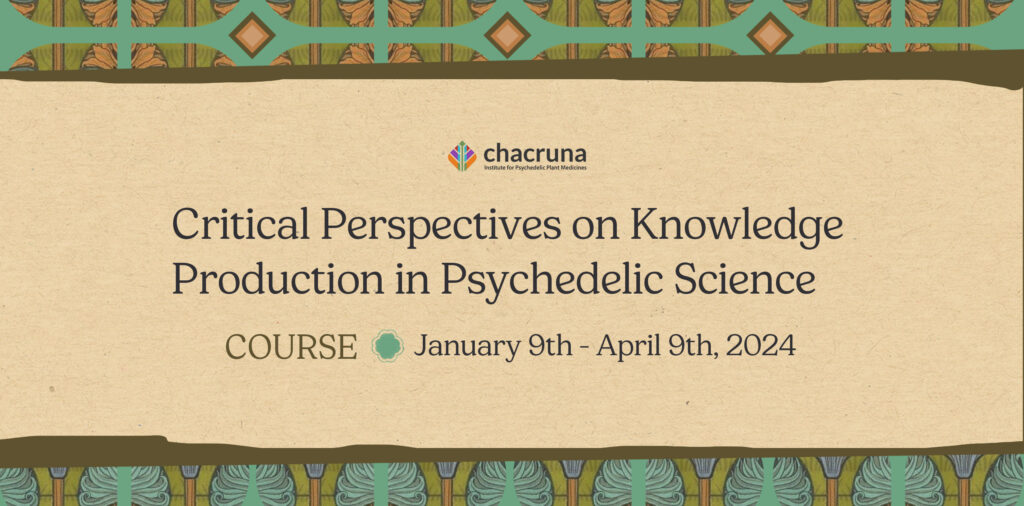
Registration is open for our “Critical Perspectives on Knowledge Production in Psychedelic Science” course.
Little by little, the visitors, including a dozen students from the Federal University of Vale do São Francisco (UNIVASF), began to retire to the camp tents in the shade of the Jatobá tree, outside the fence of the sacred area. They were exhausted, not used to walking on sand under the scorching sun of the caatinga.
The following morning, at 8:30 am, a tractor arrived pulling two trailers to transport them back to Brejo do Burgo, where they would take the bus to the UNIVASF campus in Petrolina (State of Pernambuco). One cart carried all the luggage, another had boards serving as benches.
Despite the discomfort, dust, and scorching sun on the nearly hour-long journey, no one complained. Selfies and unusual joy dominated the atmosphere in the truck. A student asked: what do we need to do to return next year?
Note: This story was originally published in Portuguese by the Brazilian daily newspaper Folha de S.Paulo.
Art by Luana Lourenço.

Shop our Collection of Psychedelic T-Shirts.
Take a minute to browse our stock:
Did you enjoy reading this article?
Please support Chacruna's work by donating to us. We are an independent organization and we offer free education and advocacy for psychedelic plant medicines. We are a team of dedicated volunteers!
Can you help Chacruna advance cultural understanding around these substances?


